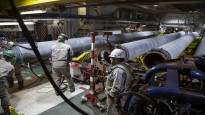The sabotage against the Nordstream gas pipeline is still unsolved.
The rupture of the Balticconnector gas pipeline between Estonia and Finland is not the first of its kind.
In January 2022, the underwater communication cable between the Norwegian mainland and Svalbard broke, according to the Norwegian authorities, “due to human activity”.
Half a year later, in September 2022, the Nord Stream gas pipeline was blown up in the international waters between Denmark and Sweden.
The cases are connected by the fact that they are still unsolved. Doubts about the perpetrator of the sabotage have also turned in the same direction – to Russia.
However, no definite information about the involvement of any state or supporting evidence has been publicly presented.
Network Director of the European Hybrid Competence Center Jukka Savolainen the difficulty of investigating sabotage depends on how the attack was carried out.
The easiest factor to find out is when there has been a surface vessel and the impact has been immediate.
The investigation becomes even more difficult if timers have been used in the explosives or they have been set off remotely.
It is most difficult to solve the sabotage if the place has been reached by submarine and the explosives have been set off later.
– It is very difficult to figure out how to use a submarine. There are sensor systems to monitor them, but they are not disclosed to the public, says Savolainen.
Satellite data in a decisive role
Investigating undercover work at sea does not differ unusually from an ordinary criminal investigation. First, let’s find out which ships have been in the vicinity of the scene.
If the ships can be identified, the next step is to investigate what their connection is to state actors.
Savolainen believes that this is how we will also deal with the broken gas pipe on Sunday.
– I don’t think it’s worth calling Russia guilty until it’s been checked whether the ship caused the damage. After that, we will find out how tightly this ship could be connected to the Russian administration. From that we can then arrive at a probability estimate of what happened, says Savolainen.
The sea areas are vast, and it is not necessarily possible to monitor all the ships moving in them and their actions precisely all the time.
Ships send information about their position, direction and speed using the AIS system. However, the ship can travel without the transmitters being on.
Such ships are still visible in satellite images.
– Now we will surely compare this information received via AIS with satellite data. If a ship has passed there in the dark, of course it arouses interest, Savolainen describes the progress of the research.
The goal is quick research
Savolainen hopes that in the investigations of Finland and Estonia, clarity on the course of events would be reached more quickly than in the case of Nord Stream.
– I hope we will not be left in the same limbo as with Nord Stream. Open and quick information would cut off the wings of the rumors that have been circulating a lot around Nord Stream.
Blowing up the Nord Stream pipeline in the Baltic Sea was an extraordinary blow, which, according to experts, was intended to possibly influence the foreign policy of European countries, for example.
Is it possible that in the sabotages seen recently, the perpetrator has finally been found out, but this information has not been – for one reason or another – wanted to be made public?
– Is that possible? That would bring the situation to the steps of a military escalation, Savolainen states.
You can discuss the topic until Friday at 11 p.m.
